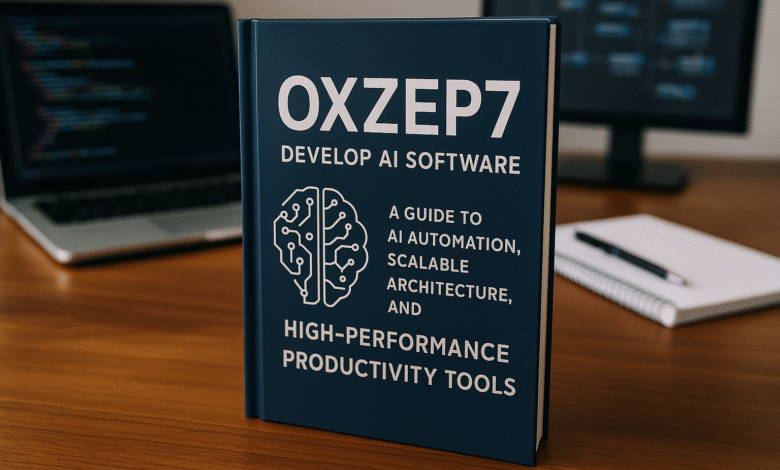Develop Oxzep7 Software: A Powerful Guide to Building a Scalable, Intelligent, and High-Performance Productivity Platform

Introduction
Develop Oxzep7 software is one of the most promising ways to build a modern, AI-driven productivity platform that helps organisations overcome workflow inefficiencies. This type of software offers strong automation, intelligent insights, and seamless collaboration, making it a positive solution for businesses that want to stay ahead in a competitive digital world. Although developing Oxzep7 software requires effort and strategic planning, the benefits outweigh the challenges when the right approach and technologies are used.
In today’s fast-moving environment, users expect software to be fast, secure, scalable, and intelligent. The Oxzep7 model is designed to meet those expectations by combining AI, modular architecture, and easy integrations. While some people may feel developing such advanced software is difficult or risky, the structured process described in this guide shows how each challenge can be turned into a strategic advantage.
Quick Bio of Oxzep7 Software (Table)
| Feature | Description |
|---|---|
| Primary Purpose | AI-powered productivity and workflow automation |
| Core Strength | Modular, scalable, cross-platform design |
| Industries Used | Healthcare, education, finance, tech startups |
| Key Technologies | Python, React.js, PostgreSQL, containerization |
| Main Capabilities | Task automation, collaboration tools, analytics, integrations |
| Unique Value | AI-driven automation with enterprise-grade security |
What Is Oxzep7 Software?
Oxzep7 software is a next-generation productivity suite focused on automating complex workflows, enhancing team collaboration, and simplifying day-to-day business operations. It is built with modular architecture, making each component easy to update, scale, or replace without affecting other features. This design helps developers create sustainable, long-term solutions that continue improving based on user needs and market trends.
The strength of Oxzep7 lies in its AI integration, which helps users manage tasks, predict outcomes, and communicate more efficiently. With capabilities ranging from automated scheduling to predictive analytics, the platform reduces manual work and ensures professionals can focus on strategic decision-making. Although there may be technical challenges, Oxzep7 ultimately provides a powerful toolkit for businesses seeking growth and efficiency.
Core Features of Oxzep7 Software
Oxzep7 comes with a wide range of intelligent features that make it stand out in the world of workflow automation. AI-driven task management, real-time collaboration tools, and predictive analytics help teams achieve more with less effort. These features create a positive impact by boosting productivity, strengthening communication, and improving decision-making.
Another major advantage is its strong security system, which includes encryption, authentication, and compliance-ready controls designed to protect sensitive information. While some traditional tools may lack modern security layers, Oxzep7 offers enterprise-level protection, ensuring trust and reliability for all users.
Requirements Gathering and Planning
The first step in developing Oxzep7 software is identifying user needs and clearly defining system objectives. Developers must understand the problems they are trying to solve, whether related to workflow delays, communication gaps, or inefficient task management. By creating user personas and mapping their journeys, developers can ensure every feature serves a meaningful purpose.
Market research is equally important, as it helps position the platform above competing tools. Understanding gaps in existing solutions allows developers to build unique and impactful features that offer true value. Though planning takes time, a well-designed roadmap saves resources and prevents expensive mistakes later.
Choosing the Right Technology Stack
Selecting the right technology stack ensures the software remains fast, flexible, and scalable. Python is the primary backend language due to its simplicity, AI compatibility, and vast community support. Frameworks like Django or Flask enable rapid development and reliable web performance.
On the frontend, React.js, Vue.js, or Angular can be used to create smooth, user-friendly interfaces that increase user satisfaction. PostgreSQL or MongoDB provide secure and scalable data storage options. While some technologies may seem difficult for beginners, the right combination results in strong performance and long-term stability.
Designing the Architecture
A microservices architecture is ideal for Oxzep7 because it allows developers to build small, independent modules. Each module can be updated, scaled, or repaired without interrupting the entire system. This provides flexibility, faster deployments, and easier troubleshooting when problems arise.
A monolithic structure may seem simpler at first, but it becomes difficult to maintain as the software grows. Microservices give teams the power to innovate faster and avoid downtimes. With proper database schema planning, developers can ensure fast querying, secure storage, and real-time analytics.
Security Measures
Security is a crucial pillar of Oxzep7 software. Building with encryption, role-based access control, and two-factor authentication improves user trust and protects against potential threats. Even though strict security protocols may require additional resources, they are essential to safeguard sensitive digital environments.
Compliance-friendly design is also important for industries such as healthcare and finance. By incorporating strong security at every layer, developers reduce risks and build a platform that users can adopt with confidence.
Developing Core Functional Modules
Oxzep7 software includes essential modules such as dashboards, automation tools, reporting engines, communication systems, and API integrations. Each module must be built as an MVP first, allowing developers to test functionality and gather feedback early.
By using an agile approach, teams can improve each module based on user expectations, fixing weaknesses before final launch. Although development may seem complex, breaking tasks into smaller parts makes everything manageable and productive.
Implementing AI and Machine Learning
AI is the backbone of Oxzep7, offering capabilities like natural language processing, predictive analytics, and intelligent recommendations. These features help automate repetitive tasks, enhance user experiences, and provide meaningful insights from data.
While AI development can be challenging, open-source libraries such as TensorFlow, spaCy, and PyTorch simplify model building. Regular training and testing ensure accuracy and consistent performance across all modules.
Frontend Development and UX Design
A clean, modern, and responsive interface is essential for user retention. Oxzep7 focuses on intuitive workflows that reduce complexity and help users complete tasks quickly. Strong UX design increases satisfaction, while accessibility standards ensure inclusivity for all users.
Developers must test the interface on various devices to guarantee compatibility. While design mistakes may disrupt user engagement, continuous refinement leads to a polished and professional user experience.
Conclusion
Developing Oxzep7 software is a powerful opportunity to create intelligent, secure, and scalable productivity tools that meet modern business needs. Though the development process includes both positive advantages and challenging steps, a structured plan ensures success. With the right technology stack, strong architecture, AI integration, and robust security, Oxzep7 becomes a high-impact platform capable of transforming how teams work, communicate, and automate tasks.
FAQ
1. What makes Oxzep7 software unique?
Oxzep7 stands out for its AI-powered automation, modular structure, and enterprise-grade security features.
2. Who can benefit from Oxzep7 software?
Industries like healthcare, education, finance, customer service, and technology startups benefit the most.
3. Why choose microservices for Oxzep7?
Microservices allow independent scaling, faster updates, and flexible maintenance.
4. How does AI improve Oxzep7 functionality?
AI enhances task automation, predictive analytics, scheduling, and user communication.
5. Is Oxzep7 secure for sensitive industries?
Yes, its encryption, authentication layers, and controlled access make it suitable for high-risk sectors.



